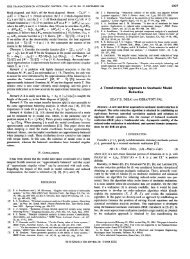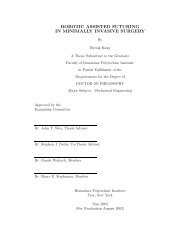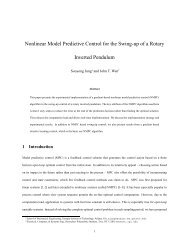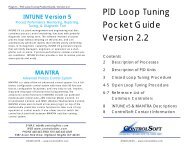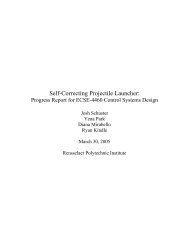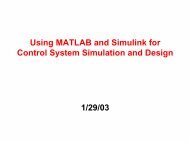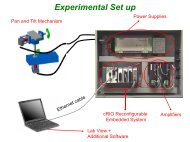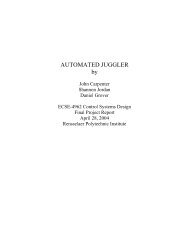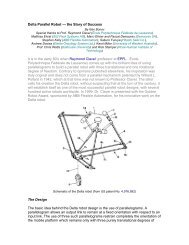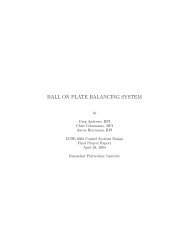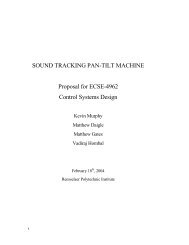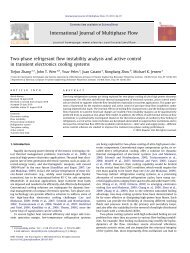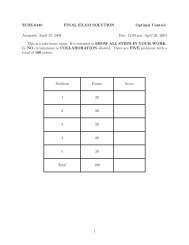ECSE.6410 MIDTERM EXAM Robotics and Automation Assigned ...
ECSE.6410 MIDTERM EXAM Robotics and Automation Assigned ...
ECSE.6410 MIDTERM EXAM Robotics and Automation Assigned ...
You also want an ePaper? Increase the reach of your titles
YUMPU automatically turns print PDFs into web optimized ePapers that Google loves.
<strong>ECSE.6410</strong> <strong>MIDTERM</strong> <strong>EXAM</strong> <strong>Robotics</strong> <strong>and</strong> <strong>Automation</strong><br />
<strong>Assigned</strong>: March 12, 2007 Due: 4:00 pm, March 19, 2007<br />
This is a take home exam. It is essential to SHOW ALL STEPS IN YOUR WORK.<br />
In NO circumstance is COLLABORATION allowed. There are FIVE problems with a<br />
total of 100 points.<br />
Problem Points Score<br />
1 20<br />
2 20<br />
3 20<br />
4 20<br />
5 20<br />
Total 100<br />
1
1. (20 points)<br />
Consider the natural logarithm of R ∈ SO(3), ln(R).<br />
(a) (10 points) Use Cayley-Hamilton Theorem to find ln(R) in terms of k <strong>and</strong> θ,<br />
where R = exp(θ k), k = 1.<br />
(Hint: Express ln(R) as a linear combination of I, R, <strong>and</strong> R 2 . Find the eigenvalues<br />
of R. Then solve for the coefficients of the linear combination.)<br />
(b) (5 points) Consider the following log-norm on SO(3):<br />
R ln := ln(R) F ,<br />
where · F denotes the Frobenius norm. Express this norm in terms of the equivalent<br />
axis-angle representation of R (i.e., (k, θ), where R = exp(θ k), k = 1).<br />
(c) (5 points) Given a target orientation Rd ∈ SO(3), suggest a kinematic control<br />
law ω as a function of R <strong>and</strong> Rd to drive R towards Rd asymptotically, based on<br />
the log-norm.<br />
(Hint: Consider V = 1<br />
<br />
<br />
R 2<br />
T d R 2 <br />
ln .)<br />
2
2. (20 points)<br />
Consider an elbow manipulator with an extra rotational joint between joints 2 <strong>and</strong> 3<br />
(see figure below when the arm is the “zero configuration”).<br />
a 3<br />
d 0<br />
h 1<br />
h 3<br />
z<br />
4<br />
0<br />
y<br />
h 4<br />
d 5<br />
1,2,3<br />
h 2<br />
x<br />
h 7<br />
5,6,7<br />
(a) (5 points) Find the Jacobian in the coordinate-free form.<br />
(b) (5 points) Characterize (describe the condition on the joint angular velocities) the<br />
self motion manifold (joint motion without end effector motion) in terms of the<br />
elbow rotation of the line between the centers of the base spherical joint <strong>and</strong> the<br />
write spherical joint.<br />
(c) (10 points) Characterize conditions for singularity when the wrist is nonsingular<br />
(describe the conditions in terms of the joint angles).<br />
(Hint: The Jacobian is singular if <strong>and</strong> only if there exists a non-zero vector v in<br />
IR 6 such that v T J = 0.)<br />
3<br />
h 6<br />
h 5<br />
d 7
3. (20 points)<br />
Consider the 3R robot shown<br />
l 1<br />
l 2<br />
h 1<br />
0,1<br />
l 3<br />
z<br />
h 2<br />
y<br />
x<br />
l 4<br />
h 3<br />
2 3 T<br />
ℓ1 = 1, ℓ2 = 0.1, ℓ3 = 1, ℓ4 = 0.2,<br />
The inverse kinematics problem is defined as finding all (q1, q2, q3) (if exist) for a given<br />
p0T ∈ IR 3 .<br />
(a) (6 points) Use the direct approach.<br />
(b) (8 points) Use subproblem decomposition (first using subproblem 1 <strong>and</strong> then<br />
subproblem 3).<br />
(c) (6 points) Use the iterative approach, i.e., the iterative solution of the minimization<br />
problem minq p0T − p(q), where p(q) is the forward kinematics map.<br />
Verify your answer in MATLAB by r<strong>and</strong>omly generating (q1, q2, q3), generate p(q),<br />
<strong>and</strong> then apply all three inverse kinematics algorithms above to verify that one of the<br />
solution is the starting (q1, q2, q3).<br />
4
4. (20 points)<br />
Consider the planar arm shown below with a circular obstacle in its workspace.<br />
y<br />
2<br />
1<br />
(3,3)<br />
2<br />
(a) (10 points) Devise a kinematic control strategy (by treating the joint angular<br />
velocity as the control variable, <strong>and</strong> the joint angular position as the feedback<br />
variable) that will move the arm from its initial vertical configuration to the final<br />
horizontal configuration while avoiding the obstacle. Discuss the rationale behind<br />
your approach, what are the possible failure scenarios (e.g., crashing into obstacle,<br />
not getting to the goal, etc.), <strong>and</strong> what are the potential remedies to failures.<br />
Hint: You may want to incorporate a simple penalty function below (or anything<br />
else you’d like to try) for collision avoidance, e.g.,<br />
f(pT ) =<br />
<br />
1<br />
g(pT ) 2 if the tip is inside the circle: pT − c < r<br />
0 otherwise .<br />
(b) (10 points) Demonstrate the effectiveness of the controller in MATLAB.<br />
5<br />
x
5. (20 points)<br />
Given N points on a rigid body, evolving in time, with position measured in the inertial<br />
coordinate frame, {ri(tj) ∈ IR 3 , i = 1, . . . , N, j = 1, . . . , K} (such as fiducial marks on<br />
a rigid body). Devise an algorithm to estimate the position <strong>and</strong> orientation of the rigid<br />
body in the inertial frame <strong>and</strong> state the conditions under which the algorithm would<br />
work.<br />
(Hint: Write down the relationship as ri = rc + Rpi, i = 1, . . . , N. First estimate R,<br />
<strong>and</strong> then rc.)<br />
6



